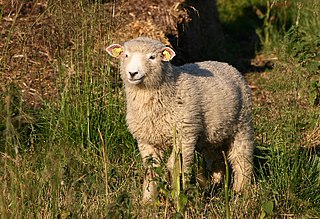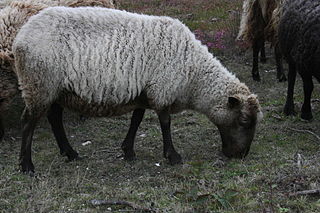A landrace is a type of domestic animal or plant adapted to the natural and cultural environment in which it originated, with minimal selective breeding. Some have "landrace" in the names:

A landrace is a domesticated, locally adapted, traditional variety of a species of animal or plant that has developed over time, through adaptation to its natural and cultural environment of agriculture and pastoralism, and due to isolation from other populations of the species. Landraces are generally distinguished from cultivars, and from breeds in the standardized sense, although the term landrace breed is sometimes used as distinguished from the term standardized breed when referring to cattle.
The term is also used informally in reference to cannabis plants to designate specific varieties, e.g. Colombian Gold, etc.; these are more properly cultivars, not landraces.

Cannabis is a genus of flowering plants in the family Cannabaceae. The number of species within the genus is disputed. Three species may be recognized: Cannabis sativa, Cannabis indica, and Cannabis ruderalis; C. ruderalis may be included within C. sativa; all three may be treated as subspecies of a single species, C. sativa; or C. sativa may be accepted as a single undivided species. The genus is widely accepted as being indigenous to and originating from Central Asia, with some researchers also including upper South Asia in its origin.

The term cultivar most commonly refers to an assemblage of plants selected for desirable characters that are maintained during propagation. More generally, cultivar refers to the most basic classification category of cultivated plants in the International Code of Nomenclature for Cultivated Plants (ICNCP). Most cultivars arose in cultivation, but a few are special selections from the wild.
Capitalized, the term is also used in the name of several "Landrace breeds", selectively-bred, standardized breeds, derived wholly or in part from actual landraces:
- Pigs
- American Landrace pig
- Belgian Landrace pig
- British Landrace pig
- Bulgarian Landrace pig
- Canadian Landrace pig
- Danish Landrace pig
- Dutch Landrace pig
- Finnish Landrace pig
- French Landrace pig
- German Landrace pig
- Italian Landrace pig
- Norwegian Landrace pig
- Polish Landrace pig
- South African Landrace pig
- Swedish Landrace pig
- Swiss Landrace pig
The American Landrace is a medium to large breed of domestic pig, white in colour, with long bodies, fine hair, long snouts, and heavy, drooping ears. They are bred for pork production.

The British Landrace is a British domestic breed of pig and one of the most popular in the United Kingdom. It is white with heavy drooping ears that cover most of the face and is bred for pork and bacon. The breed originated in the 1949 importation of 12 landrace pigs from Scandinavia — four boars and eight gilts. In 1950, the British Landrace Pig Society was formed and it opened a herd book for the first offspring born from the imported 12. They created the first pig testing scheme with a testing station at the village of Stockton-on-the-Forest in North Yorkshire.

The Danish Landrace is a medium to large breed of pig, white in colour with long bodies, fine hair, long snouts, and heavy drooping ears. They are bred for pork production. There are two distinct varieties, the white and the piebald
- Geese
- Goats
- British Landrace goat, better known as the British Primitive goat or Old British goat; it subsumes earlier classifications:
- English Landrace goat
- Irish Landrace goat
- Scottish Landrace goat
- Welsh Landrace goat
- Danish Landrace goat
- Dutch Landrace goat
- Finnish Landrace goat
- Swedish Landrace goat

The British primitive goat is a landrace of domestic goat native to Great Britain and Ireland, and is the original goat of the region. It is considered a rare breed, existing as several, isolated feral herds, as some captive populations in zoological parks and nature reserves, and breeding stock on some private farms operated by groups of rare-breed enthusiasts. As few as 1,200 individual British primitives may remain. The variety is also referred to as the British native goat, the old British goat, or the British landrace goat, among more specific names. It descends from the earliest goats brought to the region in the Neolithic era, around 3,000 BCE. It is classified in the Northern breed group of goats. A population in Northumbria is sometimes referred to as the Cheviot goat. The British primitive is among the foundation stock of some modern standardised breeds, including the Anglo-Nubian goat. The breed is comparatively small, with commensurately low milk production. It is hardy and wiry haired, adapted to rough terrain and weather, and able to subsist and breed on its own without human intervention.

The Danish Landrace goat is a breed of goat from Denmark.

The Dutch Landrace goat breed is one of the original breeds found in the Netherlands. It is related to other northwest European "Landrace"-named goat breeds. There is a herd of approximately 1000 used on national reserves to keep naturally open areas free of trees.
- Sheep
- Danish Landrace sheep
- Finnish Landrace sheep, or Finnsheep
- Old Norwegian Short Tail Landrace, or Spælsau

The Danish Landrace is a breed of sheep endemic to Jutland in Denmark. The breed, which had a population of approximately 370 in 2000, is descended from Heath sheep and Merino, with early specimen interbreeding in the 19th century with Leicester and Oxford Down sheep. While up to 10% of males have horns, the breed is mostly polled.
The Finnish Landrace, Finn or Finnsheep is a breed of domestic sheep native to Finland. It is one of several Northern European short-tailed sheep breeds, but is notable for its high incidence of multiple births – it is common for a ewe to have three, four, or even five lambs at once.

The Spælsau is a breed of sheep from Norway. Many consider Spælsau to be the original breed of sheep in Norway, and it is one of the Northern European short-tailed sheep breeds. It is well adapted to the climate and was a domestic animal from the Iron Age. The spælsau stock is about 22% of the sheep in Norway.



